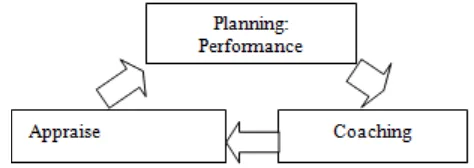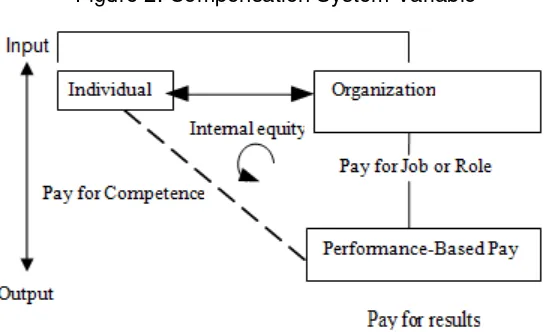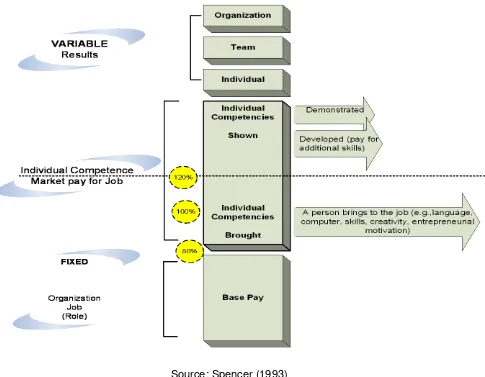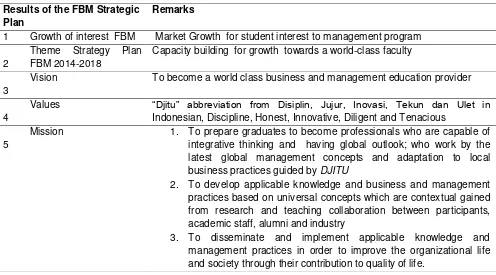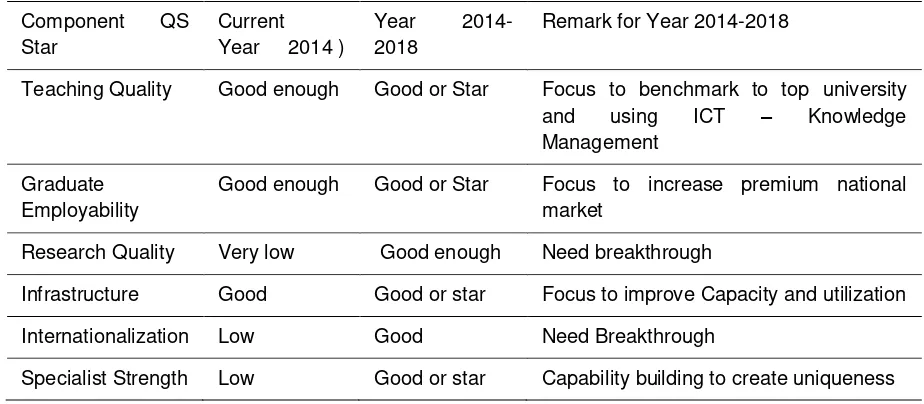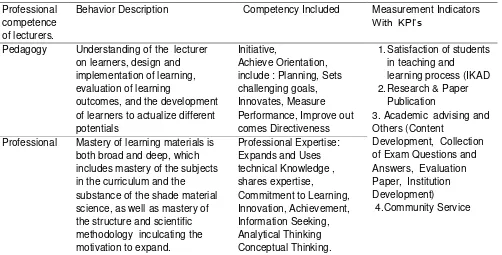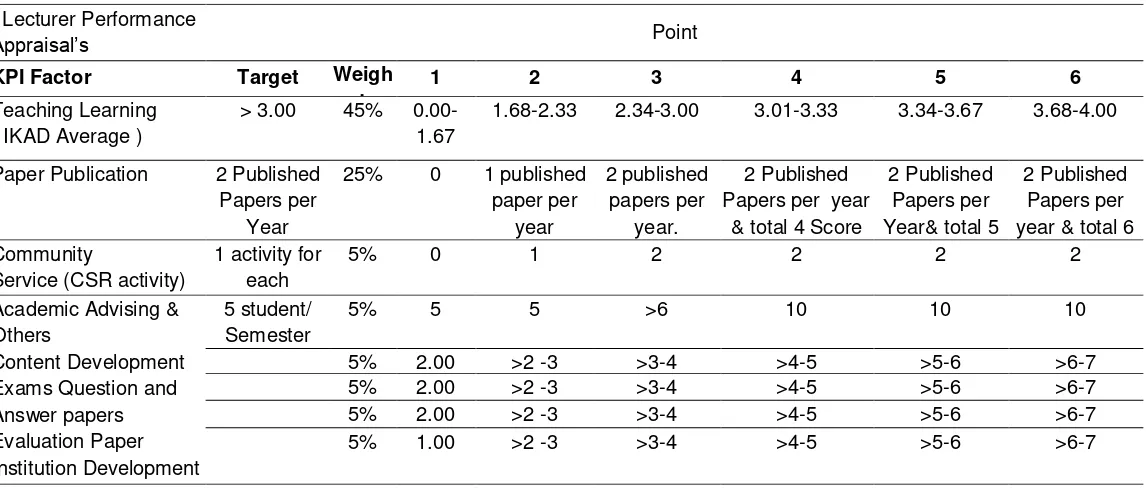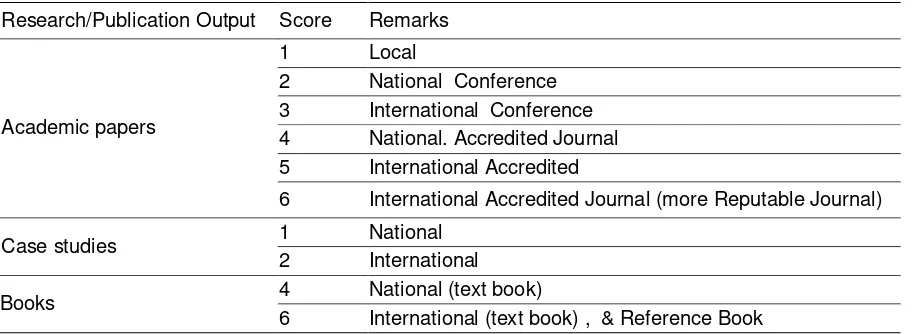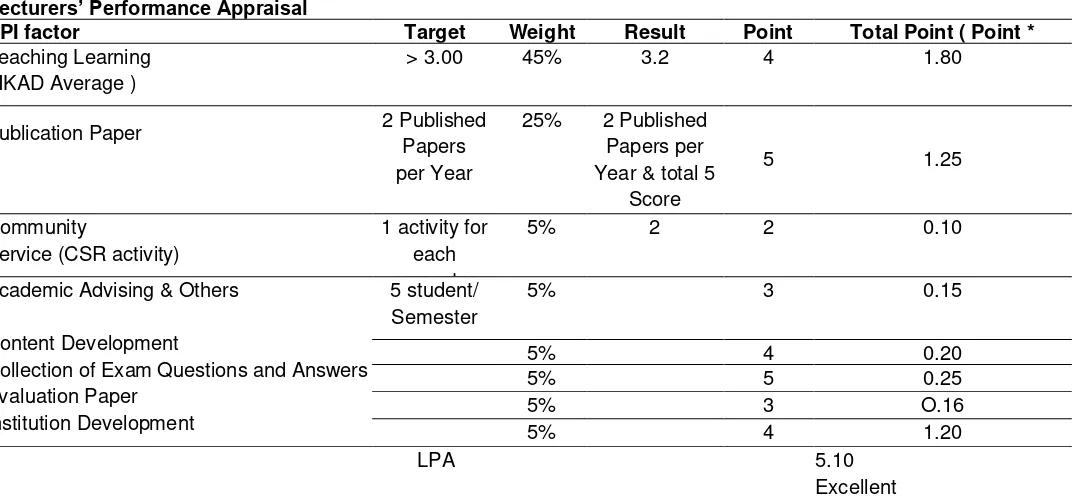Licensed under Creative Common Page 381
http://ijecm.co.uk/
ISSN 2348 0386
PERFORMANCE APPRAISAL AND REMUNERATION MODEL
FOR LECTURERS AT A UNIVERSITY EN ROUTE FOR
WORLD CLASS - A STUDY AT A FACULTY OF
BUSINESS AND MANAGEMENT
Dyah Kusumastuti
Faculty of Business & Management, Widyatama University, Bandung, Indonesia [email protected]
Abstract
This paper is exploratory and seeks a model of performance appraisal and remuneration for lecturers. In line with the endeavour towards world class, it selected a study program that is recognized as excellent and had gained a ‘Grade A’ accreditation. With the Indonesian Teacher and Lecturer Act Number 14, 2005, the concept of Globalization and Internationalization of higher education, the Human Resources audit results of the faculty, the Faculty of Business and Management Strategic Plan as its basic guidance and references, a Questionnaire was
developed for lecturers’ perception of the factors that enhance lecturers’ performance and on
their remuneration expectations. The respondents were permanent lecturers of the Faculty. Results point to a possible model of performance appraisal for world-class lecturers. It needs to bring together and integrate several key dimensions, including the major roles of Human Resources Management vis a vis service delivery, human resources development, policy and practice framework provision, organizational value implementation and monitoring, effectiveness and efficiency as well as aligning all these to the overall strategy of the university. It was also found that remuneration needs to be tied to performance in order to ensure professionalism amongst the lecturers. The Model can be used to calculate an align pay for performance, to
improve the lecturers’ competency as well as their own development and to enhance the university’s performance overall.
Licensed under Creative Common Page 382 INTRODUCTION
The 21st century economy is based on global knowledge that is informative, on proven
technology and increasingly on being societal and environmental friendly (Sanchez, 2003; Mubarak, 2012). Knowledge-based economy requires a responsive society in producing competent human resources in the face of the ever changing world. It has been established that higher education plays an important role in economic development of both developed and developing countries (Echevarria, 2009, Mubarak R. Z., Wahab Z., Khan N.R. 2012; Selesho J.M, Naile, I, 2014). Its role should actually be pre-eminent and be more aligned to societal and economic demands.
Higher Education represents a center for research, knowledge, changes and skills excellence in acquiring, producing and transferring knowledge to society. The human intellectual capital will play a central role in developing them to be the center of knowledge. Faculties/Schools provide this role and enhance excellence through their cognitive capacities (Wright, McMahan and McWilliams, 1994), skills and knowledge (Storey, 1992).
Experiences of the more advanced Asian countries like Japan, South Korea or China, showed that quality higher education correlates significantly with improvements in human resources competence that formed a high national competence. Problems in global competition need to be overcome by knowledge-based solutions. Increasingly such competitions no longer depend on natural resources and cheap labor, but on knowledge possessed and controlled by a nation. Such is the importance of knowledge in the nation‟s ability to compete.
The Indonesian Government through the Ministry of National Education encourages and helps a number of universities with the potential of moving towards World Class University
status. The major rationale to becoming a World Class University is philosophically to help its graduates acquire the ability to rapid understanding and able to adapt to the rapid global changes. The inability to adapt to these rapid changes will lead to unemployment in the global economy (http//esihairani.blogspot.com/2009/01/perguruan-tinggi-menuju-wolrd-class.html).
The globalization of management education experienced growth ranging from: 1) business schools make testing form the content of education with entrepreneurship and innovation; 2) intellectualization of management in the accreditation program. In some ways, the second wave is reflected by the growing professionalization of management itself; expanding access to education to improve the reputation (Kusumastuti, D; Agatha R, S, 2012).
The Indonesian policy involving lecturers is the UU No. 14 Year of 2005 (Law Number
Licensed under Creative Common Page 383 must possess pedagogic competency, personality self competency, social competency and professional competency acquired through professional education.
Competence consists of a range of knowledge, skills and behaviour possessed, controlled and practiced by the lecturer in their professional tasks. The Government policy also stated that lecturers‟ remuneration is made up of basic salary, bonuses associated with salary, as well as other incomes such as professional fees, secondment fees, special fees, honorary fees and bonuses associated with tasks as a lecturer determined through performance.
In order to ensure that lecturers continue to have and practice those competencies, performance appraisal and associated remuneration processes to maintain the lecturers‟ motivation need to be carried out. The expectations are that these performance appraisals are aligned with the organization‟s strategy so that the university will achieve its targets in collaboration with its staff.
Research objectives
1. To develop a Performance Appraisal Model founded on competence and achievement of the University‟s and faculties strategic plans
2. To develop Lecturers‟ Remuneration Model associated with standard competences and achievements
LITERATURE REVIEW
Indonesian government policy on Teachers and Lecturers Law No. 14 of 2005, states that the lecturers are required to have compulsory pedagogical competence, personality/self competence, social competence, and professional competence acquired through professional education.
Managing performance is perhaps the key responsibility of line managers and an area where a partnership between line and HR can be most beneficial. HR can help managers to understand how to define roles in the light of the business drivers and how to Managing and rewarding for high performance identify the capabilities required doing the job (Berger, 2001).
Licensed under Creative Common Page 384 committed to the aims of the organization. In managing performance, managers must be able to ensure that employees are appropriately focused into roles, developed and managed. According to Spencer & Spencer (1993), a Performance Management System (PMS) follow the cycle as:
Figure 1. Performance Management System (PMS) Cycle
Performance appraisal should be linked with other HR functions such as: • Remuneration or compensation, specify fixed or performance-based pay
• Succession Planning. Identify prospective employees to replace the post of key positions within the organization.
• Discipline. Trial or dismissal of the action
• Development, Training, Placement which ultimately improve the competence of employees • Career path. Assignments planning future work that is designed to give employees experience and improve specific competencies
By using competency assessment instrument that is "how to" generate performance. It is intended to seek a more precise assessment, future-oriented and focus on development. With a dynamic organizational environment, competency based approach brings a different perspective for performance management. Performance consists of behavior or competency or the process used to achieve superior performance of their job and the results or quantitative targets. A PMS that combines planning, management, and competency-based performance assessment. This competency-based performance models to assess and appreciate the performance and competence, both what employees actually "sent to the bottom line" in the past year and how they do it: they exhibit characteristics that predict superior performance in their current job, or in this study is the professional development of faculty in the future.
Licensed under Creative Common Page 385 In doing Performance Appraisals, contemporary organizations realize the importance of
competence. This happened due to the need for a more qualitative evaluation, future orientation
and focused on staff development.
An evaluation system based on competence provides a new outlook and a different perspective to management performance. It is seen as a process of using competence by staff in order to achieve results of their work. The Performance Appraisal system that includes competence shifts the emphasis of performance from the achievement of organizational objectives to staff‟s behaviour and competence in order to achieve organizational objectives. Thus such a performance appraisal points towards evaluating the behaviour or competence of those involved and not merely on the organizational results obtained. Diagnosing and solving the problem of poor performance may then be carried out as follows: If performance is not at the required level, prioritize jobs associated with this poor performance, by requesting those involved to assume the required behaviour competence as frequently as possible and develop these competences in those involved Competency Based Performance Appraisal system has the important effect on management in that managers are able to address the problems by providing the required formal competency training, exercises and development activities for the appraisal period.
Table 1. Competency Based Performance Appraisal Approaches Competency Based Performance Appraisal
COMPETENCIES (pay for competence or skill) (10%-70%)
• How performance • More qualitative
• For longer periods: future orientation
For the performance of the current and future jobs.
• Development-oriented, behavior change
PERFORMANCE( pay for results) (30%-90%)
• What or performance
• Quantitative: related goals and organizational units • The short time frame: one year, past performance • Reward oriented such as pay for results
Source: Modified from Spencer & Spencer (1993)
Spencer (1993), the steps in developing a Performance Management System as follows: 1. Identify competencies required for superior performance in the present or future jobs (competencies needed to implement the organization's strategic change of the target).
2. Develop a competency - based performance appraisal that assesses behavioral competencies and results of the performance in this case called Key performance Indicator (KPI's) that predict job performance
Licensed under Creative Common Page 386 includes an competency assessment of competency levels of employees, employee performance or KPI‟s agreement with directly supervisor
Spencer (1993), Steps in developing competency-based compensation systems such as: 1. Identify Key competencies required competencies to produce superior performance of
the job role and results in a level of performance for job family. Competency based for compensation can be shown in diagrammed as shown in figure 2.
2. Determine the relative percentage. Determine the relative percentage of total compensation for the organization wants to pay for the job role, the competence, and performance results. Competency-based payment systems typically Include all three basic factors: base salary based on work organization or in this paper is the lectureship level, plus pay extra for the success of the individual from LPA results, team performance or success team or work unit, the results of the performance of the whole organization .
Figure 2. Compensation System Variable
Licensed under Creative Common Page 387 Faculty academic hierarchy remains consist of Expert Assistant (Asisten Ahli) , Assistant Professor, (Lektor), Associate Professor ( Lektor Kepala) , and Professor (Guru Besar). For that lecturers are required to have pedagogical competency, personal/self competency, social competency, and professional competency.
Thus starting with the required job competence, the organization is able to identify the core competence that must be required by each position in the organization. In addition, each position must also have its own specific competence. The value of each of these competences needs to be predetermined and may have a range between a minimum and a maximum.
The example above shows what the expectation of the candidate should be with the associated competences, with the market variation and the availability of persons with such competences affecting the final decision the organization would take in securing such a person.
Figure 3. Hierarchy of decision making that leads to achieving the final result.
Licensed under Creative Common Page 388 METHODOLOGY
This Study used Business & Management Faculty of a private university as a sample. This Faculty has an A-level accreditation from the Indonesian National Accreditation Agency. The respondents were 50 full time lecturers of a total faculty of 71.
All our lecturer to provide 'A accreditation' the Faculty accepted. It can not be achieved if our lecturer are low quality. In selecting respondents to our survey carried out randomly from the population of 71 lecturers. They (the respondent) has been certified lecturer government issued by the Ministry of Higher Education so that non-full time lecturer has been removed to ensure the integrity of the response.
The sample size is 50 lecturers, more than 70% of the total population of full time lecturers in the Faculty, will prove statistically acceptable. To ensure the answers of the respondents also conducted tests of Cronbach‟s alpha is a statistic for reliability test. Generally it is used as a measure of internal consistency or reliability of a psychometric of research instrument. Reliability resulted Cronbach‟s Alpha, α> 0.8, which means the quality and reliability of respondents have a valid because the result is α > 0.6 for the value of the Reliability (refer table 6).
The development of Performance Appraisal and remuneration scheme used data and information from the following:
1) Faculty Strategic Plan for year 2014 -2018
2) The current management audit results of lecturers
3) The 2015 research results through a questionnaire to lecturers eliciting their thoughts on the factors that encouraged lecturers‟ performance associated with their performance appraisals and remuneration link to PA
4) The concept and theory of performance management and Indonesian Government Policy on lecturers‟ tasks per the “Tri Dharma” (Trilogy) of Higher Education.
ANALYSIS
Licensed under Creative Common Page 389 Table 2. Results of the HR Audit (HR Audit 2012)
HR Activates Current Desired
HR Strategy Example : Not well defined, HR Management leans to be administrative rather than University HR strategic
Alignment with the organization‟s strategy and
objectives
Short & long-term development plan to support the people strategy. HR Service Delivery Model should
move from “Administrative center “toward “
Core competencies derived from vision, mission, values and strategic plan .Conduct assessment to identify competency gap. For Lecturers – the pedagogy competence, professional, social and self . These competencies need to be demonstrated in the lecturers‟ behaviors in line with Tri Dharma Performance
Management
Gap between
performance management and the organization strategy
Needs Alignment with the organization‟s or faculty‟s
strategic direction and vision & mission ( “line
-of-sight”)
measuring KPI‟s ( Key Performance Indicator‟s)
Job Evaluation government policy, strategy and alignment with the Performance Management System.
Career
&Development
Does not exist well in the organization
Should be integrated with Performance Management System and Training.
Source: Analysis of HR Audit
Table 3. Results of the Faculty‟s Strategic Plan 2014-2018 Results of the FBM Strategic
Plan
Remarks
1 Growth of interest FBM Market Growth for student interest to management program
2
Theme Strategy Plan FBM 2014-2018
Capacity building for growth towards a world-class faculty
3
Vision To become a world class business and management education provider
4
Values “Djitu” abbreviation from Disiplin, Jujur, Inovasi, Tekun dan Ulet in
Indonesian, Discipline, Honest, Innovative, Diligent and Tenacious
5
Mission 1. To prepare graduates to become professionals who are capable of integrative thinking and having global outlook; who work by the latest global management concepts and adaptation to local business practices guided by DJITU
2. To develop applicable knowledge and business and management practices based on universal concepts which are contextual gained from research and teaching collaboration between participants, academic staff, alumni and industry
Licensed under Creative Common Page 390 Source: Strategic Plan Business and Management Faculty 2014-2018
Table 4. Qualitative Analysis for Faculty of Business & Management with QA-Star Component QS
Star
Current Year 2014 )
Year 2014- 2018
Remark for Year 2014-2018
Teaching Quality Good enough Good or Star Focus to benchmark to top university and using ICT – Knowledge Management
Graduate Employability
Good enough Good or Star Focus to increase premium national market
Research Quality Very low Good enough Need breakthrough
Infrastructure Good Good or star Focus to improve Capacity and utilization
Internationalization Low Good Need Breakthrough
Specialist Strength Low Good or star Capability building to create uniqueness Source: Results from Quality Audit Analysis 2014
Table 5. FBM Milestones in 2014-2026 Plan
Period Strategy Theme Main Objective
Short Term (2014-2018)
Capacity Building For Growth Towards A World-Class University
Well Define System Management And Capabilities
Middle Term (2018-2022)
Acceleration To Achievement Using Capabilities To Achieve World-Class Performance Increasingly
Long Term (2022 –
2026)
Achievement & Improvement Focus On Results Achievement And Design Next Target
Source: Millestone Strategic Plan FBM 2014-2026 6 Quality Objective • 70% on time completion with excellent results
• All graduates possess good and appropriate character to become entrepreneur
• 80% with English language competence
• An average of one national/international publication per lecturer per year
• At least 80% stakeholder satisfaction
Licensed under Creative Common Page 391 Table 6. Results of Questionnaire on Lecturers on factors that encouraged their performance in
carrying out their tasks according to „Tri Dharma‟
Statement Average Reward and Recognition for innovative and excellent lecturers 3.21 Not Yet
Joint synergy between work units and study programs in the university
3.17 Not Yet
Management system for Teaching, Learning and Research 2.97 Not Yet Facilities to support Tri Dharma activities 2.80 Not Yet
Support to develop expertise 3.40 Not Yet
Availability and functionality of system access through ICT, for new knowledge and expertise data base of Lecturers
2.91 Not Yet
* The average results are from responses in a 5-scale Liker questionnaire, from 1 : Not very Agree until 5: Strongly Agree
Table 7. Lecturers‟ statements on the link of Remuneration and Performance appraisal
Lecturers‟ Statement Average
Result **
Inference
Competence-based Performance Appraisal with determined Key performance Indicators
2.80 Agree- Strongly Agree
Clearly manifestation of Performance Management in the Planning-Implementation Coaching
2.95 Strongly Agree
Remuneration or Pay for Performance based on
Lecturers‟ Performance Appraisal results
2.60 Agree Strongly Agree
Remuneration calculates Status and the Lecturers‟
academic position
3.00 Strongly Agree
* The average results are from responses in a 5-scale Liker questionnaire, from 1 : Not very Agree until 5: Strongly Agree
THE LECTURERS’ PERFORMANCE APPRAISAL AND REMUNERATION MODEL
The steps involved in developing the Performance Appraisal and Remuneration Model are as follows:
Licensed under Creative Common Page 392 Figure 4. Staging Performance Management System
Source: Kusumastuti, D; Prabowo, H (2011)
This is performed by cascading down to the Faculty Strategic Plan , then to the lecturer, thus lecturer‟s KPI are tied to the success of the Faculty and University. Performance Appraisal evaluated through pedagogy, professional ,social, and self &personality competencies and KPI „s are achieved, as shown in figure 7.
b. Development of four standard competencies and measurement indicators as required by the education Tri Dharma summarized in the following Table 8:
Table 8. Developing KPIs for the four lecturers‟ standard competency Professional
competence of lecturers.
Behavior Description Competency Included Measurement Indicators
With KPI‟s
Pedagogy Understanding of the lecturer on learners, design and implementation of learning, evaluation of learning
outcomes, and the development of learners to actualize different potentials Professional Mastery of learning materials is
Licensed under Creative Common Page 393 Social The ability of lecturers to
communicate and interact ability of personal identity that reflects the personality of a solid, stable, mature person in relation to others and to work wisely and authoritatively,
Source: Develop from Boyatzis, R.. E. (2008); Spencer (1993); Indonesian government policy number 14 year 2005 on Teachers & Lecturers.
c. The Lecturers‟ Performance Appraisal is then done by measuring the four indicators where each KPI factor carries targets which are cascaded through the Faculty‟s target, while the weighting of each KPI factor is determined by the government‟s policy by their percentages in order to calculate the credit value for lecturers in Indonesia.
Table 9. Results of Performance Appraisal‟s components of the Tri Dharma
Source: Modified Kusumastuti,D & Prabowo,H .(2011)
Note: The performance index (IKAD) ranges from 1 (lowest) to 4 (highest) and calculated students’ satisfaction obtained through a questionnaire distributed at the end of the semester.
Lecturer Performance
1.68-2.33 2.34-3.00 3.01-3.33 3.34-3.67 3.68-4.00
Licensed under Creative Common Page 394 For performance calculation Performance Appraisal for Paper Publication with to assess the performance Lecturer in Research done by calculating the scoring of the paper output generated by the lecturer, as defined in Table 9, as follows:
Table 10. Shows the process of quantifying lecturers‟ performance on Research Research/Publication Output Score Remarks
Academic papers
1 Local
2 National Conference 3 International Conference 4 National. Accredited Journal 5 International Accredited
6 International Accredited Journal (more Reputable Journal)
Case studies 1 National
2 International
Books 4 National (text book)
6 International (text book) , & Reference Book
Table 11 . Point Lecturer Performance Appraisal
Performance Criteria total result point can be described as follows:
Table 12. Performance Criteria total result point
LPA Point KPI Description Competency Description
1 Significantly do not meet performance standards and targets set
Demonstrate basic development needs compared with job competencies required
2 Do not achieving performance standards and targets set
Perform key actions yet but have significant development needs in several important actions.
3 In general meet appropriate performance standards and targets set.
Doing adequate in some key actions but have significant development needs in at least one key action
4 Achieve all performance standards and targets set
Perform the actions of key importance; development needs at least one or key actions or complex 5 Achieve all performance standards and even
exceed the targets set but not all of them.
Superior in some but not all of the key actions
Do not have a significant development needs in achieving the key actions.
6 Significantly above performance standards and targets set.
Superior performance in all key actions ; full mastery of all aspects of this competency
Total Point of LPA Grade
1-2 Less
>2-3 Less - Marginally
>3-4 Good
>4-5 Very Good
Licensed under Creative Common Page 395 On Academic Advising, the lecturers‟ performance is measure by way of students‟ satisfaction level in their final year project and the number of students the lecturers supervised. As before the scoring ranges from 1 – lowest to 4 – highest.
The assessment of other KPI factors such as Contents Development, Collection of Exam Questions and Answers, lecturers‟ Paper evaluation and Institutional Development is done by looking at the results of the output factors and their quality calculated per Table 9.
d. The results of the lecturers‟ Performance Appraisal are calculated on a year basis with score values between 1 and 6.
To elucidate the process an illustrative example is given here.
Ñame: John Idol, Status: Full Time, Position: Associate Professor
Table 13. Illustration
Lecturers’ Performance Appraisal
KPI factor Target Weight Result Point Total Point ( Point *
Teaching Learning ( IKAD Average )
> 3.00 45% 3.2 4 1.80
Publication Paper 2 Published
Papers per Year
.
25% 2 Published Papers per Year & total 5
Score
5 1.25
Community
Service (CSR activity)
1 activity for each semester
5% 2 2 0.10
Academic Advising & Others
Content Development
Collection of Exam Questions and Answers Evaluation Paper
Institution Development
5 student/ Semester
5% 3 0.15
5% 4 0.20
5% 5 0.25
5% 3 O.16
5% 4 1.20
Licensed under Creative Common Page 396 Thus, Performance Appraisal, can be done once a year at the end of the performance period for reviewing, evaluating and completing achievements / KPI results and competence. Performance Appraisal is also a process to review the areas of improvement and future development plans of the lecturers.
e. Development of the Remuneration Model
Fig.3 and Fig. 4 shows how the remuneration model is developed. In this case, however, the government policy on remunerating government civil servants is used as a guideline in addition to the integrated concept that links the Lecturers‟ Performance Appraisal with Human Resources aspects such as remuneration, training and career development.
The 3P (Position/Grade , Performance, People) approach of the remuneration management system supports the University‟s or faculty‟s strategy, mission and objectives. The 3-P system ensures that HRM plays a central role in management decision making and the achievement of University goals.
Figure 5. Pay for Position, Pay for Performance, Pay for People
Source: Kusumastuti (2011)
To Pay for position align with grade academic position and the amount of credit value lecturer lecturers are:
Expert Assistant (Assistant Expert) - Credit value = 100 and 150, Assistant Professor (Lecturer) - Credit value = 200 & 300, Associate Professor - Credit value = 400 & 550 & 700, Professor (Professor) - Credit value = 850 & 1050
Which became Fixed pay is linked to academic faculty positions, while the variable pay is the result of the PA, in which already covers the competency of the lecturer.
3P
Pay for Position:
Position Based fair Compensation System
Pay for Performance: Performance Based fair Compensation System
Pay for People:
Competency Based fair Compensation System
To Attract
To maintain and Retain in short term
Licensed under Creative Common Page 397 SUMMARY OF THE FINDINGS AND CONCLUSION
To maintain professionalism to ensure lecturers as Knowledge worker has Competency pedagogy, Competency professional, Competency social and Personality/Self Competency and prevent professional decay lecturer, the University needs to do LPA is to assess KPI's achievement is Performance lecturer in IKAD (index performance Academic Lecturer, Publication Paper , Community Service (CSR activity), Academic Advising & Others, Content Development, Collection of Exam Questions and Answers, Evaluation paper, Institution Development which in turn results LPA is associated with a remuneration system through Three (3) Pay (Position / Grade, Performance, People).
Lecturer who pay a fixed remuneration depending on the level of academic positions, while variable pay depends on the results of the PA. In accordance Spencer (1993), that the Integrated Human Resource Management Information System is shared by all human resource functions that Provides a common language and integrated all HR service by using the Job Database and People Competencies competency requirements.
For lecturers who have additional job such as position Rector, Dean, Head of Department need to be in charge of Job Competency requirements and Key Performance Indicator further LPA Lecturer with Double Role This position is added to the LPA with setting % weighting as in Table 1.
From the results if the research data of Table 5 and Table 6, the questionnaire statement lecturers to improve performance and maintain professionalism lecturers need encouragement university leadership that can describe the vision and mission, to give freedom of Choice (freedom lecturers) to cultivate expertise and professional services expertise outside the university, manage energy / spirit to foster the spirit of learning and achievement, harness the potential and creativity.
In addition to the above to encourage Lecturer performance, the need for the University: • Work to develop synergy between the units, program study to encourage faculty performance.
• The management system that is easy and fit for the professional people can use easily and not time consuming
• Assistant lecturer to support the development expertise of lecturers
LECTURE PERFORMANCE APPRAISAL (LPA) =
Licensed under Creative Common Page 398 • The availability and functioning of ICT-based access can be used lecturers as well as access to new knowledge gained access database expertise ease.
• Assess performance clearly Lecturer components resulting in "performance" Separation "between the lecturer and the results of performance related remuneration should make lecturers are motivated to improve their performance in the Tri Dharma ( Trilogy) HE.
• Remuneration Structures as Knowledge Worker Lecturer ranging from 3 Pay, taking into account the method of determining the amount, payment strategies and Total Take Home Pay by linking academic faculty position and results of LPA.
From Bossidy,L.& Charan, R. 2002, Execution in this paper is a model Lecturer Performance Appraisal and Remuneration, this needs to be a core element of the culture of an organization. Execution should be embedded in the reward system and the norms of behavior practiced by everyone. This is necessary for the execution of three foundations that need to be built within the University, namely 1) Essential Top Leader Behavior, 2) creation of Culture Execution and 3) The Job No Leader Should Delegate so Having the right People in the Right Place. Leader Behavior required for execution includes the Know Your People and Business, insist on Realism, Develop Goals & Priorities, Follow through (clear targets need to be managed seriously), Award for actors, Expand people‟s Capabilities via Coaching and Know Yourself. While the creation of the foundation Culture Execution Tell manner clearly to everyone, the result of what to expect, and then discuss how to obtain the results, as part of the coaching process. Then you give awards to those who succeed. If they still do not meet expectations, you give extra coaching, do not give him a reward, give another job, or let them go. Three is the foundation for the Job No. Should Delegate leader so Having the right People in the Right Place. Why the Right People Are not in the Right Jobs? The answer is probably not enough Leader know about the people they have chosen, Leader may take the fun for him (psychologically unpleasant), than anyone else who has a better ability to work, the leader might not have the courage to distinguishes great performer with bad performers, and then take the necessary action.
Keep in mind that the execution-oriented Leader allocate significant time and energy to the process of human resource development and keep the best talents continue to show their best performance.
Licensed under Creative Common Page 399 IMPLICATIONS OF THE STUDY
First, to develop Human Capital Management, which is a strategic activity that aims to ensure that the university will have sufficient competencies in the long term frame.
Second, Resource Integration of business processes in university . This activity is done through mapping and resource goals every business process in the university into the competencies that can do the exchange and integration of resources across business processes in a university using a standard language that in the form of formulation types of competency.
Third, Knowledge Management; that lecturer with similar competency can together using various knowledge management tools such as Lesson Learned, Technical documents, and so on for the Sharing knowledge and practical experience and then Creating Knowledge to be applied in the faculty or university
Fourth, Communication across functions in the university can be done more clearly and more accurate to use title and description competency standardized, making it possible to utilize Knowledge of lecturers among faculty within the university
LIMITATIONS
a. Veracity of any extrapolation to other faculties and other universities may be difficult to justify due to the different natures of other faculties.
b. A more confident conclusion may be obtained perhaps if results from doing this at a similar faculty in another university was conducted. We acknowledged the problem of involving external organization and given the competitive environment, this idea would not have got off the ground.
c. The homogeneity of the sample could be a factor that need to be looked at more rigorously as are demographics.
REFERENCES
Berger, L.A. & Berger, D.R. (Eds.). (2004). The Talent Management Handbook Creating Organizational Excellence by Identifying, Developing, and Promoting Your Best People, by The McGraw-Hill Companies, Inc. All rights reserved, Manufactured in the United States of America, 0-07-141434-7. Bossidy, L. & Charan, R. (2002). Execution: the discipline of getting things done , ISBN 1-400-04617-3, 2002.
Boyatzis, R. E. (2008). “Competencies in the 21st century”, Journal of Management Development, Case
Licensed under Creative Common Page 400 Holbeche, Linda. (2001). Aligning HR and business strategy” Title 658.3 ,ISBN 0 7506 5362 0
Butterworth-Heinermann Edition , inacre House, Jordan Hill, Oxford OX2 8DP, 225 Wildwood , Avenue, Woburn, MA 01801-2041, A Publishing LtdM.
Kusumastuti, D & Prabowo, H. (2011). Aligning of Knowledge Management and People Management Case of Private University in Indonesia. Presented in SEAAIR 2011, Chiang Mai – Thailand 2011, Proceeding SEAAIR 2011, International Publication, Page 112 – page 117.
Kusumastuti, D. (2011). Aligning Human Resource and Business Strategy , Proceedings Competitiveness through Integrated System an International Seminar at Widyatama University in collaboration with De La Salle Lippa Philippines, ISBN:978-979-25-0221-3, pp 49-55
Kusumastuti, D. (2014). Identifying competencies that predict effectiveness of disaster managers at local government Int. J. Society Systems Science, Vol. 6, No. 2, 2014 159, Publishers: Inderscience , page 159-176 DOI: 10.1504/IJSSS.2014.062437.
Kusumastuti,D.& Agatha, R.( 2012). “Globalization and Internationalization in Business and Management
Education”, Presented – ICOI – Airlangga University, 2012 , Proceeding . Internatioal) ISBN 978 986 8568 2 66, page 457 – page 475
Mubarak, R. Z., Wahab Z., Khan N.R. (2012) Faculty retention in higher education institutions of Pakistan
– Ricerche di Pedagogia e Didattica – International Journal of Theories and Research in Education 7, (2), 66-78 .
Sanchez, F. (2003). Skills for a Knowledge-Based Economy. Leadership, 33(2), 30-33.
Selesho, J.M & Naile, I.(2014). Academic Staff Retention As A Human Resource Factor: University Perspective , Vaal University of Technology, South Africa Idah Naile, Vaal University of Technology, South Africa International Business & Economics Research Journal –March/April 2014 Volume 13, Number 2 , Retrieved from http://www.academia.edu/ 6658796/ Academic_Staff_Retention_ As_A_Human_ Resource_ Factor_ University_ Perspective, 2015
Spencer & Spencer. (1993). “Competence at work”, John Wiley Sons, Inc, ISBN 0-471-54809-X, 1993 Storey, J. (1992). Developments in the Management of Human Resources. Oxford: Black-well.
UU No. 14 Year of 2005 (Law Number 14, 2005), Undang Undang Guru & Dosen ( Teacher and Lecturer) , Indonesia Government Policy .
